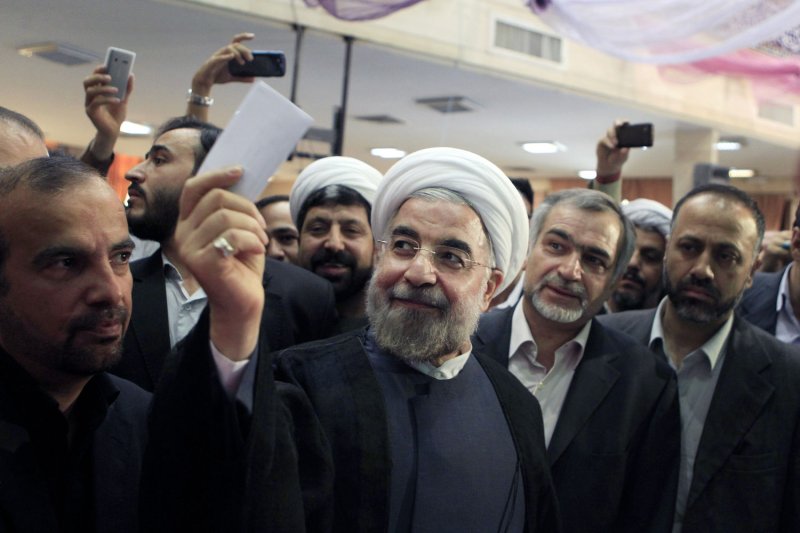Iran's former top nuclear negotiator and presidential candidate Hassan Rouhani shows his ballot paper prior to voting in Iran's presidential elections at a polling station in Tehran, Iran on June 14, 2013. Iran's Supreme Leader Ayatollah Ali Khamenei urged all Iranians to vote and slammed suggestions by the United States that the election would be a sham. UPI/Maryam Rahmanian |
License Photo
HERNDON, Va., June 18 (UPI) -- A debate reignited every August upon the anniversary of the atomic bomb dropped on Hiroshima during World War II is: Did the United States have a moral obligation to demonstrate to Japan beforehand that it possessed a singularly unique weapon capable of destroying cities?
U.S. military concerns about a pre-bombing demonstration were twofold: 1) there were only two bombs, which would necessitate expending one on such a demonstration; and 2) should the weapon fail to detonate, would the bomb's failure to perform only encourage further resistance by the Japanese.
Having successfully tested the detonation of a nuclear device on July 16, 1945, the United States rushed to deploy the two weapons against the Japanese homeland. The first fell on Hiroshima on Aug. 6; the second on Nagasaki on Aug. 9.
Quick deployment was encouraged as U.S. intelligence had learned Tokyo might be close to testing its own nuclear device in what is now North Korea on Aug. 12. (As the Soviets occupied northern Korea after the war, Japan's nuclear program status was never verified.)
History proved the United States right in foregoing a demonstration of its atomic weaponry as its full arsenal would have to be used to convince Tokyo to surrender unconditionally.
There are parallels today between dropping an atomic bomb on Japan to end its nuclear program during World War II and dropping a newly developed bomb on another enemy -- Iran -- to end its nuclear program.
For those who find labeling Iran an "enemy" objectionable, it is naive to consider otherwise.
Iran has declared war on the United States both by deed and action repeatedly over the last 34 years -- to which the United States continuously turned a blind eye. Accordingly, Iran has tallied more U.S. deaths than any country since the United States fought Vietnam.
Iran's war against the United States began with its initial violation of international law in seizing the U.S. Embassy in November 1979. While no American lives were lost, getting away with that inspired Tehran to launch a death tally as it became a catalyst in various terrorist acts, mostly through its Hezbollah proxy, including the kidnapping and killing U.S. hostages in Lebanon in 1982, the 1983 Beirut bombing of the Marine barracks and the U.S. Embassy there, the 1996 Khobar Towers bombing, its indirect involvement in 9/11, its support of militants in Iraq and Afghanistan, its provision of improvised explosive devices to those battlefields, etc.
Iran's track record of aggression will only increase once it possesses a nuclear weapon.
Like Japan during its war with the West, Iran has undertaken its own nuclear weapons program. It has made repeated references to the fact it won't hesitate to use such a weapon once developed.
With its nuclear weapons program near completion, Tehran took precautions to protect many facilities by burrowing and hardening them deep underground. With some as deep as 260 feet, Tehran's leadership believes they will be safe from any conventional weapons attack.
While the United States has been working on the development of a deep ground-penetrating bomb since 2004, it wasn't until early this year the final product was tested. The GBU-57 Massive Ordnance Penetrator, weighing in at 30,000 pounds with a 31.5-inch diameter and 20.5-foot length, is GPS-guided and capable of penetrating 200 feet before detonating.
In an effort to ease Israeli concerns as to the bomb's effectiveness, to conduct a demonstration, the United States spent millions of dollars to construct a replica of an Iranian nuclear site deep underground. The most current version of the bomb has recently been further improved by adding a detonator fuse capable of withstanding "impact with layers of granite and steel" and of rejecting guidance-jamming attempts.
The good news is the test demonstration on the replica went well; the bad news is only eight of the bombs are on order.
As the Iranians have often made dubious claims about their own weaponry, they probably don't take seriously any claim of the GBU-57 MOP's capability to destroy their underground facilities. And with only eight bombs and numerous underground nuclear facilities to target, none should be wasted on another demonstration.
Iranian President Mahmoud Ahmadinejad has never been one to allow facts to interfere with his fiction. Photos and film footage of the Holocaust, for example, have failed to convince him such barbarism ever occurred. He is obviously a "show me" kind of guy, only convinced by firsthand experience.
Let's hope when the GBU-57 MOP is dropped in Iran, Ahmadinejad quickly gains that firsthand experience.
--
(A retired Marine, Lt. Colonel Zumwalt served in the Vietnam War, the U.S. invasion of Panama and the first Gulf War. He has written "Bare Feet, Iron Will -- Stories from the Other Side of Vietnam's Battlefields," "Living the Juche Lie: North Korea's Kim Dynasty" and "Doomsday: Iran -- The Clock is Ticking.")
--
(United Press International's "Outside View" commentaries are written by outside contributors who specialize in a variety of important issues. The views expressed do not necessarily reflect those of United Press International. In the interests of creating an open forum, original submissions are invited.)















